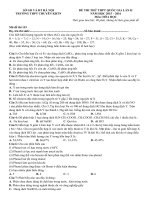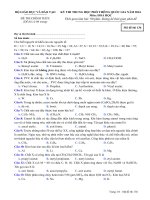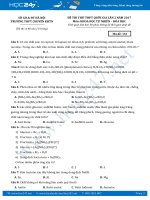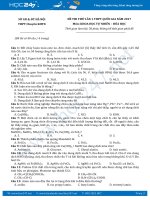- Trang chủ >>
- Đề thi >>
- Tuyển sinh lớp 10
Đề thi Cambridge IGCSE™ chính thức môn Hoá tháng 062023 (Đề trắc nghiệm_Số 23_ Nâng cao_Có đáp án)
Bạn đang xem bản rút gọn của tài liệu. Xem và tải ngay bản đầy đủ của tài liệu tại đây (452.49 KB, 19 trang )
Cambridge IGCSE™
CHEMISTRY
0620/23
Paper 2 Multiple Choice (Extended)
May/June 2023
45 minutes
You must answer on the multiple choice answer sheet.
*4817069418*
You will need: Multiple choice answer sheet
Soft clean eraser
Soft pencil (type B or HB is recommended)
INSTRUCTIONS
There are forty questions on this paper. Answer all questions.
For each question there are four possible answers A, B, C and D. Choose the one you consider correct
and record your choice in soft pencil on the multiple choice answer sheet.
Follow the instructions on the multiple choice answer sheet.
Write in soft pencil.
Write your name, centre number and candidate number on the multiple choice answer sheet in the
spaces provided unless this has been done for you.
Do not use correction fluid.
Do not write on any bar codes.
You may use a calculator.
INFORMATION
The total mark for this paper is 40.
Each correct answer will score one mark.
Any rough working should be done on this question paper.
The Periodic Table is printed in the question paper.
This document has 16 pages. Any blank pages are indicated.
IB23 06_0620_23/5RP
© UCLES 2023
[Turn over
2
1
Nitrogen is heated in a balloon, which expands slightly.
Which statements about the molecules of nitrogen are correct?
A
2
1
They move further apart.
2
They move more quickly.
3
They remain the same distance apart.
4
Their speed remains unchanged.
1 and 2
B
1 and 4
C
2 and 3
D
3 and 4
The diagrams represent some elements, compounds and mixtures.
1
2
3
4
Which row describes the numbered substances?
3
1
2
3
4
A
element
mixture of compounds
compound
mixture of elements
B
compound
mixture of compounds
element
mixture of elements
C
element
mixture of elements
compound
mixture of compounds
D
compound
mixture of elements
element
mixture of compounds
Two atoms, X and Y, have the same mass number but different atomic numbers.
Which statement about X and Y is correct?
A
They have the same number of protons.
B
They have the same number of electrons.
C
They are in the same group of the Periodic Table.
D
They have different numbers of neutrons.
© UCLES 2023
0620/23/M/J/23
3
4
A sample of pure iron contains three isotopes only.
percentage
abundance
of isotope / %
isotope
2
n
6
54
92
56
Fe
Fe
Fe
The iron in the sample has a relative atomic mass of 55.9.
What is the value of n?
A
5
53
B
55
C
57
D
58
Magnesium oxide is a white solid at room temperature and pressure.
Part of the structure of solid magnesium oxide is shown.
key
= Mg2+ magnesium ion
= O2– oxide ion
Three statements are listed.
1
Magnesium ions are smaller than oxide ions because they contain fewer electrons.
2
Magnesium oxide has good electrical conductivity when molten because the ions
are mobile.
3
Magnesium oxide has a high melting point because of the strong electrostatic
attraction between the ions and delocalised electrons in the giant lattice.
Which statements are correct?
A
6
1 and 2
B
1 and 3
C
2 and 3
D
2 only
In which molecule are all the outer-shell electrons involved in covalent bonding?
A
Cl 2
© UCLES 2023
B
CH4
C
HCl
0620/23/M/J/23
D
NH3
[Turn over
4
7
8
9
Which row describes the properties of silicon(IV) oxide?
giant covalent
structure
melting point
A
no
high
B
no
low
C
yes
high
D
yes
low
Which row describes the structure of a solid metal and explains the property?
structure of solid metal
property of solid metal
A
lattice of negative ions
in a sea of electrons
conducts electricity because
the electrons are free to move
B
lattice of negative ions
in a sea of electrons
is malleable because the layers
of ions can slide over each other
C
lattice of positive ions
in a sea of electrons
conducts electricity because
the ions are free to move
D
lattice of positive ions
in a sea of electrons
is malleable because the layers
of ions can slide over each other
What is the formula of potassium oxide?
A
P2O
B
PO2
C
KO
D
K2O
10 A dilute aqueous solution of sodium bromide is electrolysed using inert electrodes.
Which row identifies the product at the cathode and at the anode?
cathode
anode
A
bromine
hydrogen
B
hydrogen
bromine
C
hydrogen
oxygen
D
oxygen
hydrogen
© UCLES 2023
0620/23/M/J/23
5
11 Aluminium is extracted by electrolysis, as shown.
graphite anode
steel case
–
+
–
+
aluminium oxide
dissolved in
molten cryolite
graphite cathode
molten aluminium
Which row shows the ionic half-equations at the cathode and the anode?
cathode
anode
A
Al 3+ Al + 3e–
2O2– O2 + 4e–
B
Al 3+ Al + 3e–
2O2– + 4e– O2
C
Al 3+ + 3e– Al
2O2– O2 + 4e–
D
Al 3+ + 3e– Al
2O2– + 4e– O2
12 The reaction pathway diagram for an exothermic reaction is shown.
3
1
energy
2
4
progress of reaction
Which row identifies labels 1, 2, 3 and 4?
1
2
3
4
A
reactants
H
Ea
products
B
products
H
Ea
reactants
C
reactants
Ea
H
products
D
products
Ea
H
reactants
© UCLES 2023
0620/23/M/J/23
[Turn over
6
13 The equation for the complete combustion of ethene is shown.
C2H4(g) + 3O2(g) 2CO2(g) + 2H2O(g)
Some bond energies are listed.
bond
bond energy
in kJ / mol
C–H
412
C–C
348
C=C
612
C–O
360
C=O
743
O–O
146
O=O
496
O–H
463
What is the overall energy change when one mole of ethene is completely burned?
A
–456
B
–1076
C
–1340
D
–2126
14 Magnesium reacts with hydrochloric acid to form magnesium chloride and hydrogen.
Why does magnesium powder react faster than magnesium ribbon?
A
The magnesium atoms in the powder have a lower activation energy.
B
The powder has a smaller surface area.
C
The magnesium atoms in the powder have more frequent collisions with acid particles.
D
The magnesium atoms in the powder have greater kinetic energy.
15 Which row shows the conditions used in the Contact process?
catalyst
pressure
/ atm
temperature
/ C
A
iron
2
100
B
iron
200
450
C
vanadium(V) oxide
2
450
D
vanadium(V) oxide
200
100
© UCLES 2023
0620/23/M/J/23
7
16 A student heats hydrated copper(II) sulfate. The blue crystals change to a white powder.
How can the student reverse this reaction?
A
Add anhydrous copper(II) sulfate to the white powder.
B
Add water to the white powder.
C
Cool the white powder.
D
Reheat the white powder.
17 Which reaction of hydrochloric acid is a redox reaction?
A
MgCO3 + 2HCl MgCl 2 + H2O + CO2
B
Mg(OH)2 + 2HCl MgCl 2 + 2H2O
C
MgO + 2HCl MgCl 2 + H2O
D
Mg + 2HCl MgCl 2 + H2
18 Which oxide is amphoteric?
A
Al 2O3
B
CaO
C
Na2O
D
SO2
19 Four statements about strong acids are listed.
1
They react with carbonates to form carbon dioxide.
2
They completely dissociate in aqueous solution.
3
They react with ammonium salts to form ammonia.
4
They are proton acceptors.
Which statements are correct?
A
1 and 2
B
1 and 3
C
2 and 4
D
3 and 4
20 Which reaction mixture will produce a precipitate?
A
aqueous Na2CO3 and aqueous CuSO4
B
dilute H2SO4 and aqueous NaOH
C
dilute HNO3 and solid MgO
D
solid CuO and dilute H2SO4
© UCLES 2023
0620/23/M/J/23
[Turn over
8
21 Which set of elements shows the change from metallic to non-metallic character across a period
of the Periodic Table?
A
beryllium magnesium calcium
B
fluorine bromine iodine
C
oxygen boron lithium
D
sodium silicon chlorine
22 A sample of ethanoic acid and a sample of hydrochloric acid have the same concentration.
How do the hydrogen ion concentration and pH of ethanoic acid compare to those of
hydrochloric acid?
ethanoic acid compared
to hydrochloric acid
hydrogen ion
concentration
pH
A
higher
higher
B
higher
lower
C
lower
higher
D
lower
lower
23 What is a typical property of transition elements?
A
can act as catalysts
B
poor electrical conductivity
C
low melting point
D
low density
24 Which statement about copper or aluminium is correct?
A
Aluminium is more dense than copper.
B
Aluminium is less reactive than copper.
C
Copper has high ductility.
D
Copper has poor electrical conductivity.
© UCLES 2023
0620/23/M/J/23
9
25 Water from a reservoir flows to the water works where purification process 1 takes place followed
by process 2.
What are processes 1 and 2?
process 1
process 2
A
chlorination
filtration
B
filtration
chlorination
C
fractional distillation
filtration
D
filtration
fractional distillation
26 Calcium reacts with cold water to produce hydrogen.
Lead reacts slowly when heated in air to form an oxide but has almost no reaction with steam.
Silver does not react with either air or water.
Zinc reacts when heated with steam to produce hydrogen.
What is the order of reactivity starting with the least reactive?
least reactive
most reactive
A
calcium
lead
zinc
silver
B
calcium
zinc
lead
silver
C
silver
lead
zinc
calcium
D
silver
zinc
lead
calcium
27 Blocks of magnesium are attached to the bottom of a steel boat to prevent rusting.
Which equation describes a change that prevents the steel from rusting?
A
Fe Fe3+ + 3e–
B
Fe2O3 + 3Mg 2Fe + 3MgO
C
3Mg2+ + 2Fe 2Fe3+ + 3Mg
D
Mg Mg2+ + 2e–
© UCLES 2023
0620/23/M/J/23
[Turn over
10
28 Which statements about the extraction of iron in a blast furnace are correct?
A
1
The temperature inside the blast furnace is increased by burning carbon.
2
Iron(III) oxide is reduced to iron by carbon monoxide.
3
The thermal decomposition of calcium carbonate forms slag.
4
Slag reacts with acidic impurities.
1 and 2
B
1 and 4
C
2 and 3
D
3 and 4
29 Which statements about water are correct?
A
1
Tap water has fewer impurities than distilled water.
2
Tap water will turn anhydrous cobalt(II) chloride pink.
3
The domestic water supply is treated with carbon to kill microbes.
4
Phosphates from fertilisers can cause deoxygenation of water.
1 and 2
B
1 and 3
C
2 and 4
D
3 and 4
30 Oxides of nitrogen form in car engines and are removed by catalytic converters.
Which equation represents a reaction that occurs in a catalytic converter?
A
CO + NO2 NO + CO2
B
2CO + 2NO N2 + 2CO2
C
CO2 + NO NO2 + CO
D
CO2 + 2NO2 N2 + 3O2 + C
31 An alkene is represented by the formula CH3CH=CH2.
Which name is given to this type of formula?
A
displayed
B
empirical
C
general
D
structural
© UCLES 2023
0620/23/M/J/23
11
32 What is the structure of propanoic acid?
A
H
H
H
C
C
H
H
B
O
C
H
OH
H
H
H
C
C
C
H
H
H
C
OH
D
C
H
O
H
H
H
C
C
C
H
H
H
H
OH
H
H
H
H
C
C
C
C
H
H
H
H
OH
33 Butane reacts with chlorine in the presence of ultraviolet radiation.
What is the equation for this reaction?
A
C4H10 + Cl 2 C4H8Cl 2 + H2
B
C4H10 + Cl 2 C4H9Cl + HCl
C
C4H10 + Cl 2 2C2H5Cl + H2
D
C4H10 + Cl 2 C2H4 + C2H5Cl + HCl
34 A hydrocarbon P is cracked to make compound Q and hydrogen.
Compound R is formed by the addition polymerisation of compound Q.
To which homologous series do P, Q and R belong?
alkene
alkane
A
P only
Q and R
B
Q only
P and R
C
P and Q
R only
D
P and R
Q only
35 Which substances are structural isomers?
A
but-2-ene and propene
B
ethyl ethanoate and butanoic acid
C
methyl methanoate and ethanol
D
propan-1-ol and butan-1-ol
© UCLES 2023
0620/23/M/J/23
[Turn over
12
36 Ethanol is produced by:
1
the catalytic addition of steam to ethene
2
fermentation.
Which statement is correct?
A
Both processes use similar amounts of energy.
B
Both processes use a catalyst.
C
Process 1 uses a temperature of 25–35 °C.
D
Process 2 uses a pressure of 60 atm.
37 The two monomers shown can be used to form a condensation polymer.
O
C
H
O
H
H
H
H
C
C
C
C
H
H
H
H
H
O
C
N
O
H
H
H
H
H
H
H
H
C
C
C
C
C
C
H
H
H
H
H
H
H
N
H
Which small molecule is released during this reaction?
A
H2O
B
NH3
C
CO2
D
CONH2
38 Dilute hydrochloric acid is titrated into a conical flask containing sodium hydroxide solution and a
few drops of methyl orange indicator.
Which piece of apparatus is used to add the hydrochloric acid?
A
beaker
B
burette
C
measuring cylinder
D
pipette
© UCLES 2023
0620/23/M/J/23
13
39 The chromatogram obtained from a chromatography experiment on substance S is shown.
4.5 cm
solvent front
4.7 cm
S
6.0 cm
baseline
1.8 cm
What is the Rf value of S?
A
0.39
B
0.46
C
0.56
D
0.62
40 Element X burns in air to form an acidic gas that decolourises potassium manganate(VII).
What is X?
A
carbon
B
nitrogen
C
magnesium
D
sulfur
© UCLES 2023
0620/23/M/J/23
14
BLANK PAGE
© UCLES 2023
0620/23/M/J/23
15
BLANK PAGE
Permission to reproduce items where third-party owned material protected by copyright is included has been sought and cleared where possible. Every
reasonable effort has been made by the publisher (UCLES) to trace copyright holders, but if any items requiring clearance have unwittingly been included, the
publisher will be pleased to make amends at the earliest possible opportunity.
To avoid the issue of disclosure of answer-related information to candidates, all copyright acknowledgements are reproduced online in the Cambridge
Assessment International Education Copyright Acknowledgements Booklet. This is produced for each series of examinations and is freely available to download
at www.cambridgeinternational.org after the live examination series.
Cambridge Assessment International Education is part of Cambridge Assessment. Cambridge Assessment is the brand name of the University of Cambridge
Local Examinations Syndicate (UCLES), which is a department of the University of Cambridge.
© UCLES 2023
0620/23/M/J/23
© UCLES 2023
21
45
39
Y
12
Mg
magnesium
24
20
Ca
calcium
40
38
11
Na
sodium
23
19
K
potassium
39
37
22
73
Ta
72
Hf
89
57–71
lanthanoids
88
56
0620/23/M/J/23
Rf
Db
Th
thorium
232
–
90
89
Ac
140
139
actinium
Ce
cerium
La
231
protactinium
Pa
91
141
praseodymium
Pr
59
58
57
lanthanum
–
dubnium
–
rutherfordium
105
181
tantalum
93
238
uranium
U
92
144
neodymium
Nd
60
–
seaborgium
Sg
106
184
tungsten
W
74
96
molybdenum
Mo
42
52
chromium
Cr
24
–
neptunium
Np
93
–
promethium
Pm
61
–
bohrium
Bh
107
186
rhenium
Re
75
–
technetium
Tc
43
55
manganese
Mn
25
–
plutonium
Pu
94
150
samarium
Sm
62
–
hassium
Hs
108
190
osmium
Os
76
101
ruthenium
Ru
44
56
iron
Fe
26
27
28
29
30
Pt
–
americium
Am
95
152
europium
Eu
63
–
meitnerium
Mt
109
192
–
curium
Cm
96
157
gadolinium
Gd
64
–
darmstadtium
Ds
110
195
platinum
Ir
iridium
78
106
palladium
Pd
46
59
nickel
Ni
77
103
rhodium
Rh
45
59
cobalt
Co
–
berkelium
Bk
97
159
terbium
Tb
65
–
roentgenium
Rg
111
197
gold
Au
79
108
silver
Ag
47
64
copper
Cu
–
californium
Cf
98
163
dysprosium
Dy
66
–
copernicium
Cn
112
201
mercury
Hg
80
112
cadmium
Cd
48
65
zinc
Zn
B
C
–
einsteinium
Es
99
165
holmium
Ho
67
–
nihonium
Nh
113
204
thallium
Tl
81
115
–
fermium
Fm
100
167
erbium
Er
68
–
flerovium
Fl
114
207
lead
Pb
82
119
tin
Sn
In
indium
50
73
germanium
Ge
32
28
silicon
Si
14
12
carbon
49
70
gallium
Ga
31
27
aluminium
Al
13
11
boron
6
–
mendelevium
Md
101
169
thulium
Tm
69
–
moscovium
Mc
115
209
bismuth
Bi
83
122
antimony
Sb
51
75
arsenic
As
33
31
phosphorus
P
15
14
nitrogen
N
7
–
nobelium
No
102
173
ytterbium
Yb
70
–
livermorium
Lv
116
–
polonium
Po
84
128
tellurium
Te
52
79
selenium
Se
34
32
sulfur
S
16
16
oxygen
O
8
–
lawrencium
Lr
103
175
lutetium
Lu
71
–
tennessine
Ts
117
–
astatine
At
85
127
iodine
I
53
80
bromine
Br
35
35.5
chlorine
Cl
17
19
fluorine
F
9
–
oganesson
Og
118
–
radon
Rn
86
131
xenon
Xe
54
84
krypton
Kr
36
40
argon
Ar
18
20
neon
Ne
10
4
5
helium
VIII
1
VII
hydrogen
VI
2
V
He
IV
1
III
H
Group
The volume of one mole of any gas is 24 dm3 at room temperature and pressure (r.t.p.).
actinoids
lanthanoids
–
–
actinoids
Ra
radium
Fr
104
88
87
francium
178
89–103
137
133
hafnium
Ba
barium
Cs
caesium
91
Nb
niobium
55
Zr
zirconium
85
yttrium
Sr
strontium
41
51
vanadium
V
Rb
40
48
titanium
Ti
23
relative atomic mass
rubidium
scandium
Sc
9
7
name
atomic symbol
Be
beryllium
Li
lithium
atomic number
4
3
Key
II
I
The Periodic Table of Elements
16
Cambridge IGCSE™
CHEMISTRY
0620/23
Paper 2 Multiple Choice (Extended)
May/June 2023
MARK SCHEME
Maximum Mark: 40
Published
This mark scheme is published as an aid to teachers and candidates, to indicate the requirements of the
examination.
Mark schemes should be read in conjunction with the question paper and the Principal Examiner Report for
Teachers.
Cambridge International will not enter into discussions about these mark schemes.
Cambridge International is publishing the mark schemes for the May/June 2023 series for most
Cambridge IGCSE, Cambridge International A and AS Level and Cambridge Pre-U components, and some
Cambridge O Level components.
This document consists of 3 printed pages.
© UCLES 2023
[Turn over
0620/23
Cambridge IGCSE – Mark Scheme
PUBLISHED
Question
Answer
May/June 2023
Marks
1
A
1
2
B
1
3
D
1
4
C
1
5
D
1
6
B
1
7
C
1
8
D
1
9
D
1
10
C
1
11
C
1
12
A
1
13
B
1
14
C
1
15
C
1
16
B
1
17
D
1
18
A
1
19
A
1
20
A
1
21
D
1
22
C
1
23
A
1
24
C
1
25
B
1
26
C
1
27
D
1
28
A
1
© UCLES 2023
Page 2 of 3
0620/23
Cambridge IGCSE – Mark Scheme
PUBLISHED
Question
Answer
May/June 2023
Marks
29
C
1
30
B
1
31
D
1
32
A
1
33
B
1
34
B
1
35
B
1
36
B
1
37
A
1
38
B
1
39
C
1
40
D
1
© UCLES 2023
Page 3 of 3









